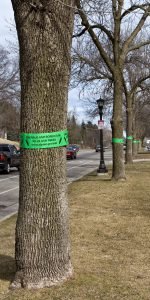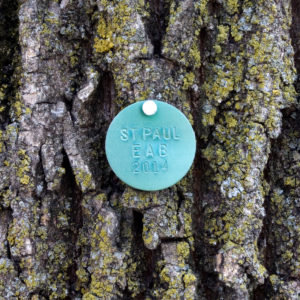By MARGIE O’LOUGHLIN
The Emerald Ash Borer (EAB) is an invasive beetle that made its way to North America 15 years ago. Adult beetles eat ash foliage, causing little damage—but larvae feed on the inner bark, killing ash trees by cutting off the transport of water and nutrients.
 According to Rachel Coyle, City of St. Paul Urban Forester, “The EAB will eventually claim all our ash trees. That amounts to about 25% of St. Paul’s boulevard trees, and is a staggering loss of our urban forest.”
According to Rachel Coyle, City of St. Paul Urban Forester, “The EAB will eventually claim all our ash trees. That amounts to about 25% of St. Paul’s boulevard trees, and is a staggering loss of our urban forest.”
Photo right: The City of St. Paul has marked hundreds of ash trees with green ribbons as part of a public awareness campaign. This stretch of trees along Marshall Ave. east of the Lake St. Bridge is being treated for EAB infestation. (Photo by Margie O’Loughlin)
The EAB first showed up in Great Lakes shipping ports in 2002, in packing crates from overseas. It has since spread to 29 states and two Canadian provinces; its arrival in Minnesota was confirmed in 2009. Every North American ash species is susceptible to the EAB, which will kill all untreated trees it encounters within ten years.
The City of St. Paul has done extensive marking of ash trees with green ribbons, directing interested persons to their website to learn more about the infestation at www.stpaul.gov/eab. The green ribbons are part of a public awareness campaign to inform people of just how many ash trees line St. Paul boulevards.
According to Coyle, “The ash was a natural choice to replace elm trees lost to Dutch Elm Disease in the 1970’s. It’s an inexpensive tree, and it grows fast. Unfortunately, there are monocultures of ash planted throughout St. Paul. We have about 18,000 planted along city boulevards, and we’ve decided to treat 3,500 with an insecticide to kill the EAB.”
The ash trees that the City of St. Paul is treating are in highly visible locations, with trunk diameters measuring between 10-20”. The chemical used to treat them is a non-neonicotinoid, meaning that it doesn’t pose a threat to pollinators. Derived from natural products, the chemical TREEage is considered the “lowest-risk.”
 Photo left: The City of St. Paul has decided to chemically treat 3,500 of its 18,000 boulevard Ash trees for Emerald Ash Borer. Treated trees bear a metal tag on the street-side at about 4’ off the ground. The trees are treated every three years. (Photo by Margie O’Loughlin)
Photo left: The City of St. Paul has decided to chemically treat 3,500 of its 18,000 boulevard Ash trees for Emerald Ash Borer. Treated trees bear a metal tag on the street-side at about 4’ off the ground. The trees are treated every three years. (Photo by Margie O’Loughlin)
“We’re treating the trees we can,” Coyle said, “and those we can’t treat we’re removing. We’ve been doing what we call ‘Structured Removal’ since 2010, where we take out whole blocks at a time. Our primary concern now is removing infested trees, and there’s a backlog of those. The trees are a safety hazard. We currently have funding to remove about 1,000 trees per year.”
According to Coyle “the Forestry Department received less money than we had requested from the city this year. We’ve removed 800 trees so far in 2017 and, unfortunately for those customers, there is no funding available for stump grinding and tree replacement.
“We expect homeowners to be very upset about this,” she said. As Coordinator of the EAB Management Program, Coyle is used to delivering news to homeowners that they don’t want to hear. She encouraged citizens to contact their city council member and the mayor’s office to express their opinions about the budget shortfall.
Karen Zumach, forester and vice president of the Minnesota Shade Tree Advisory Committee (MNSTAC) reiterated those thoughts. “Everyone has to start making a lot more noise,” she said, “and if municipalities can’t provide replacement trees, invest in them yourselves. If a legislator hears about an issue five times, it will rise to the top of their list of constituent concerns.”
Zumach explained, “The death curve for EAB is rising, and more trees are going to start dying faster. MNSTAC advocates for treating far more trees than our current funding will allow. With our unprecedented number of ash trees, Minnesota has more to lose than any other state—and our municipalities have been too slow in responding.”
The goal of MNSTAC is to create a centralized funding source to deal with the EAB infestation. Their bill has requested funding from the state in the last two legislative sessions. While it has strong bipartisan support, its outcome is still unclear. Zumach concluded, “With proper funding, municipalities could treat their ash trees for twenty years for less cost than removing and replacing them.”
Homeowners can obtain a free permit for planting a boulevard tree at their expense on city property.
Once the application is received, a city forester will schedule a site visit and make a recommendation for what type of tree to choose. Visit www.stpaul.gov/forestry to apply for a permit.
“Boulevard trees are subject to the peculiar pressures of road salt, restricted root growth, and pollution from cars, Coyle said. “Consult with the visiting forester, but stay open-minded. If you’re investing in a tree, you may actually be better off planting it in your yard than on the boulevard.”
Coyle cautioned that we need to learn from our mistakes: invasive species are not going to end with the EAB. If choosing a new boulevard or yard tree, her strongest suggestion was to not plant a maple. She said, “The next anticipated invasive insect species is the Asian Longhorn Beetle, and its preferred food source is maple trees.”
Comments
No comments on this item Please log in to comment by clicking here